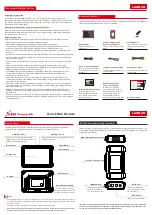
1-877-528-6249
www.launchtechusa.com
1820 S. Milliken Ave
Ontario, CA 91761
2
.
CRP 12
X
Premium
2. General Information
2.1 On-Board Diagnostics (OBD) II
The first generation of On-Board Diagnostics (OBD I) was developed by the California Air Resources Board (ARB) and implemented in 1988 to
monitor some of the emission control components on vehicles. As technology evolved and the desire to improve the On-Board Diagnostic system
increased, a new generation of On-Board Diagnostic system was developed. This second generation of On-Board Diagnostic regulations is called
“OBD II”.
The OBD II system is designed to monitor emission control systems and key engine components by performing either continuous or periodic tests
of specific components and vehicle conditions. When a problem is detected, the OBD II system turns on a warning lamp (MIL) on the vehicle
instrument panel to alert the driver typically by the phrase of “Check Engine” or “Service Engine Soon”. The system will also store important
information about the detected malfunction so that a technician can accurately find and fix the problem. Here below follow three pieces of such
valuable information:
1) Whether the Malfunction Indicator Light (MIL) is commanded ‘on’ or ‘off’;
2) Which, if any, Diagnostic Trouble Codes (DTCs) are stored;
3) Readiness Monitor status.
2.2 Diagnostic Trouble Codes (DTCs)
OBD II Diagnostic Trouble Codes are codes that are stored by the on-board computer diagnostic system in response to a problem found in the
vehicle. These codes identify a particular problem area and are intended to provide you with a guide as to where a fault might be occurring within
a vehicle. OBD II Diagnostic Trouble Codes consist of a five-digit alphanumeric code. The first character, a letter, identifies which control system
sets the code. The second character, a number, 0-3; other three characters, a hex character, 0-9 or A-F provide additional information on where
the DTC originated and the operating conditions that caused it to set. Here below is an example to illustrate the structure of the digits:
Figure 2-1
2.3 Location of the Data Link Connector (DLC)
The DLC (Data Link Connector or Diagnostic Link Connector) is typically a 16-pin connector where diagnostic code readers interface with the
vehicle’s on-board computer. The DLC is usually located 12 inches from the center of the instrument panel (dash), under or around the driver’s
side for most vehicles. If Data Link Connector is not located under dashboard, a label should be there telling location. For some Asian and
European vehicles, the DLC is located behind the ashtray and the ashtray must be removed to access the connector. If the DLC cannot be found,
refer to the vehicle’s service manual for the location.
Содержание Premium CRP 12 Series
Страница 1: ...CRP 12X Premium Manual LAUNCH TECH USA...
Страница 20: ...CRP 12X Premium Manual LAUNCH TECH USA...






































